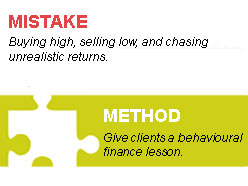
Investors can be their own worst enemies, says Gary Gorr, an advisor with Worldsource Financial Management in Toronto.
The danger comes from making investment decisions based on emotion, not logic. For example, buying or selling out of an overreaction to the latest news.
The forces behind human behaviour drive investment decisions, too. So, advisors need to help clients employ more reason and less passion. Here are five ways:
-
OPEN THEIR EYES
A restaurant with a lineup is more enticing, even though next door’s a better bargain. Investors follow crowds, too; witness gold prices.
Following makes clients feel safe, but they pay a premium for that feeling. So you must explain the things that make an investment popular—e.g. a perceived high rate of return (often pumped by the media)—may not be valid, or may be entirely wrong for the client’s strategy or risk tolerance.
-
OFFER PERSPECTIVE
Would you stop flying because of turbulence? If yes, then good thing you didn’t own Apple when it plunged to $13.35 in 2003. Today, the stock is above $380. Turbulence is temporary, and a stock with good fundamentals will regain its altitude.
Volatility is relatively unimportant if you’re looking at longer investment horizons and have a well diversified portfolio. Explain poor performance in one asset class will be offset with stronger performance in another over time.
-
DIFFERENTIATE PORTFOLIO AND PLAN
A plan centres on a goal; the portfolio is a tool to achieve it. Keep edgy clients focused on the destination, be it snowbirding in Phoenix or paying for a child’s education.
Show clients what will happen to their investments given optimistic, pessimistic and reasonable return assumptions. The worst-case scenario only means the ride will take longer; but hitting traffic doesn’t mean you won’t arrive, and certainly shouldn’t mean you abandon the journey.
-
PROBE FOR MOTIVATIONS
A client tells you he wants to shift some of his portfolio into a certain sector, or invest in a rental property. Ask why. If you grasp the underlying rationale, says Gorr, you can respond with logic. Is the client trying to keep up with neighbours? If so, would that threaten his long-term goals? Bring the discussion back to the client’s best interests.
-
RE-FRAME THE DISCUSSION
In one study, people who were told they could keep 40% of a sum of money gambled with it 43% of the time. When told they could lose 60%, they gambled 62% of the time. The odds were identical, but framing the option differently altered decisions. Framing happens when investors fret about a small part of their portfolios and lose sight of overall returns. That can lead to dangerous behaviour, like suddenly changing their risk tolerances. So, frame the discussion as an assessment of where the client stands relative to achieving his or her goals.
